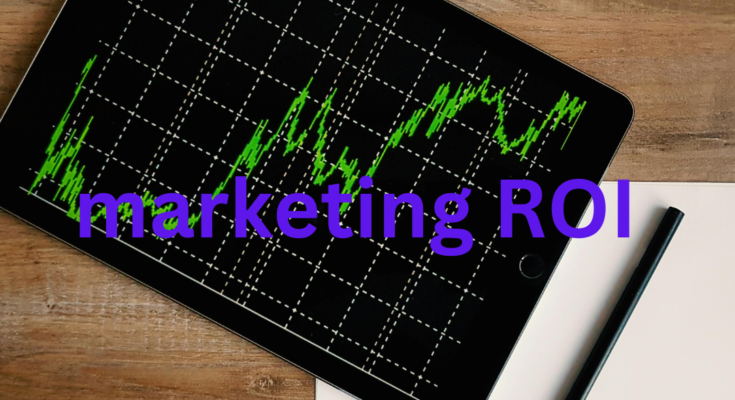Making use of data analytics to maximize your marketing ROI
Today’s market has turned a full 180 degrees. Marketers are increasingly using data analytics to lead the decision-making processes for information-driven decisions on maximizing marketing Return on Investment (ROI). Businesses can see actionable information with the huge volumes of available data to optimize campaigns, hit the right audience, and improve their customer experience. The article discusses ways in which data analytics can be used to improve marketing ROI.
What is Marketing ROI?
As a key performance indicator (KPI), Marketing ROI determines the long-term effectiveness of investments in various marketing approaches and methods within an organization. Marketers learn how much revenue or value was created from investments made on different marketing strategies.
Collect Data And Analyze It
The first step in improving your ROI is to ensure that you are collecting and analyzing the right data. Begin assembling data from every touchpoint available on your marketing channels. This includes:
Website analytics: Collect data on user behavior, page views, bounce rates, conversion rates, and average session duration.
Social media metrics: Track engagement rates, reach, clicks, and shares on platforms such as Facebook, Instagram, and LinkedIn.
Email campaign data: Open rates, click-through rates, and conversion rates via your email marketing efforts.
Paid advertising data: Data from pay-per-click campaigns, display ads, and any other paid channels that will give you show-measurements like Cost Per Acquisition (CPA), Return On Ad Spend (ROAS), and Cost per Lifetime Value (CLV).
By topping up data from different sources, you will build a comprehensive view of how your marketing efforts are working across different channels. Which, in turn, will allow you to spot patterns, trends, and even shortfalls.
Segment Your Audience
Data can work to your advantage in segmenting the audience based on various issues: demographics, behavior, and purchase patterns. Once you figure out the right segments, targeting them with relevant messaging should help to boost engagement and conversion rates.
Sample segments to consider:
Demographics: Age, Gender, Location, Income etc.
Behavioral data: Website Interactions, Past Purchases, Product Views etc.
Psychographics: Customer values, preferences, and lifestyle.
Using analytics tools, such as Google Analytics, customer relationship management (CRM) software, or marketing automation platforms, you can build precise customer profiles. These insights help in creating personalized campaigns that resonate with each group, increasing the likelihood of conversions and improving ROI.
Optimize Campaigns in Real-Time
One of the greatest benefits with data analytics is the option to analyze the campaign in real-time. You can make real-time adjustments rather than waiting until the campaign is over to assess its performance.
For example, if you run a social media ad campaign and notice that certain demographics or ad creatives are performing better than others; you can immediately reallocate your budget in real-time to maximize those high-performing segments. Likewise, if the email campaign fails to generate the anticipated results, you could test different subject lines, messages, or calls to action in real-time.
By optimizing your campaign with real-time data, you’ll eliminate any wastage of ad spend and ensure you get the best ROI possible.
Harness the Power of Predictive Analytics
Predictive analytics are processes that employ historical data, statistical algorithms, and machine learning approaches to forecast future events or outcomes. Predictive models allow marketers to know their clients’ behavior, project demand, and optimize functions regarding customer allocation. An example could be:
Customer Lifetime Value (CLV): This enables predictive analytics to derive the value of a customer in the long-term by analyzing past behavior or different interactions of the company with the customer. Companies can then focus their marketing efforts on customer retention, where there is the highest potential CLV.
Lead Scoring: Predictive models can help create an outward intelligence score on leads, assisting marketers in prioritization and resource allocation.
Sales Forecasting: Predictive analytics can predict how sales will trend and adjust campaigns per expected demand.
By predictive analytics, you can make data-driven decisions that enhance targeting, improve customer retention, optimize campaign spend-driving higher ROI.
Measure the Contribution of Each Channel
Different marketing channels can have different effectiveness levels depending on your business and your audience. Data analytics allows you to measure your performance across the various channels, such as organic search, paid search, social media, and content marketing.
Key metrics to track for each channel will include:
Cost per lead (CPL)
Cost per acquisition (CPA)
Click-through rate (CTR)
Return on Ad Spend (ROAS)
Conversion rate
By looking into these metrics, you will know which channels provide the best value for their costs. For instance, you might find that email marketing provides the best ROI, while social media ads fall short. This will give you the insight to re-prioritize your resources toward a more rewarding platform.
A/B Testing for Continuous Improvement
A/B testing is probably one of the most important methods available for increasing marketing return on investment (ROI). This entails setting two versions of a single marketing asset (an email, landing page, or advertisement) against each other to see which performs better.
Monitor Customer Feedback and Sentiment
Data analytics tools can also be used to monitor customer feedback and sentiment. Tracking customer reviews, social media mentions, and survey results can provide valuable insights into your brand’s perception.
By analyzing sentiment data, you can adjust your marketing messaging to address pain points, improve customer satisfaction, and increase retention. A positive customer experience not only drives repeat business but also generates word-of-mouth referrals, ultimately boosting your marketing ROI.
Conclusion
Data analytics is a powerful tool that can transform how businesses approach marketing. By collecting and analyzing data, segmenting audiences, optimizing campaigns in real-time, leveraging predictive analytics, and using A/B testing and attribution models, marketers can make informed decisions that lead to improved ROI.
The key is to continuously monitor and refine your marketing strategies based on actionable insights from data. By doing so, you can ensure your marketing efforts are as efficient and effective as possible, resulting in a greater return on investment for your business.

